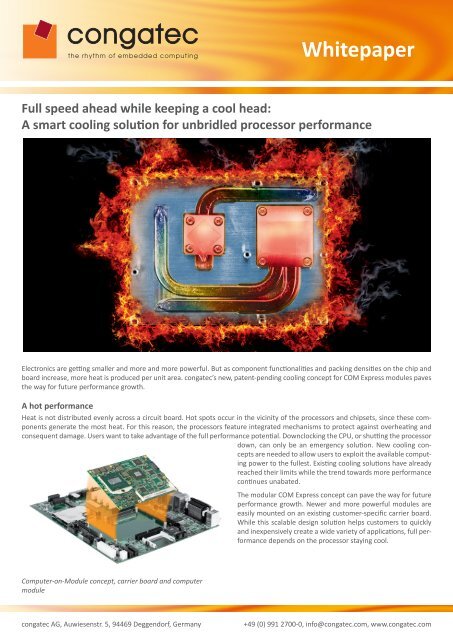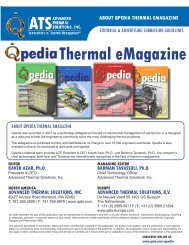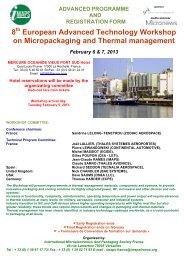Full speed ahead while keeping a cool head - coolingZONE
Full speed ahead while keeping a cool head - coolingZONE
Full speed ahead while keeping a cool head - coolingZONE
Create successful ePaper yourself
Turn your PDF publications into a flip-book with our unique Google optimized e-Paper software.
Whitepaper<br />
<strong>Full</strong> <strong>speed</strong> <strong>a<strong>head</strong></strong> <strong>while</strong> <strong>keeping</strong> a <strong>cool</strong> <strong>head</strong>:<br />
A smart <strong>cool</strong>ing solution for unbridled processor performance<br />
Electronics are getting smaller and more and more powerful. But as component functionalities and packing densities on the chip and<br />
board increase, more heat is produced per unit area. congatec’s new, patent-pending <strong>cool</strong>ing concept for COM Express modules paves<br />
the way for future performance growth.<br />
A hot performance<br />
Heat is not distributed evenly across a circuit board. Hot spots occur in the vicinity of the processors and chipsets, since these components<br />
generate the most heat. For this reason, the processors feature integrated mechanisms to protect against overheating and<br />
consequent damage. Users want to take advantage of the full performance potential. Downclocking the CPU, or shutting the processor<br />
down, can only be an emergency solution. New <strong>cool</strong>ing concepts<br />
are needed to allow users to exploit the available computing<br />
power to the fullest. Existing <strong>cool</strong>ing solutions have already<br />
reached their limits <strong>while</strong> the trend towards more performance<br />
continues unabated.<br />
Computer-on-Module concept, carrier board and computer<br />
module<br />
The modular COM Express concept can pave the way for future<br />
performance growth. Newer and more powerful modules are<br />
easily mounted on an existing customer-specific carrier board.<br />
While this scalable design solution helps customers to quickly<br />
and inexpensively create a wide variety of applications, full performance<br />
depends on the processor staying <strong>cool</strong>.<br />
congatec AG, Auwiesenstr. 5, 94469 Deggendorf, Germany +49 (0) 991 2700-0, info@congatec.com, www.congatec.com
Cooling solution composition: heat pipes<br />
Description of the individual components<br />
of congatec’s <strong>cool</strong>ing pipe solution<br />
Whitepaper<br />
Classic <strong>cool</strong>ing designs for up to<br />
35W TDP<br />
The classic COM <strong>cool</strong>ing design resembles<br />
a sandwich with the different functions<br />
layered on top of each other. A<br />
copper or aluminium block is mounted<br />
on the chip to absorb heat. Between the<br />
chip and copper or aluminium block,<br />
an optional phase-change material can<br />
be placed to mitigate the effects of<br />
thermal peaks. To account for different<br />
component heights and manufacturing<br />
tolerances, the next layer is a heightbalancing,<br />
thermally conductive material,<br />
the so-called gap filler. The last layer<br />
consists of a heatspreader, an approximately<br />
3mm thick aluminium or copper<br />
plate. All heat generated by the module<br />
is distributed across the complete heatspreader.<br />
The module dimensions and interfaces are defined by the COM Express specification.<br />
While this standardization guarantees compatibility, size specifications may mean that<br />
the heat sink cannot necessarily be as large as desired. As a consequence this <strong>cool</strong>ing<br />
structure is only suitable for modules with a maximum power dissipation of 35W.<br />
Hot spots unwelcome<br />
Modern COM Express modules such as the conga-TS77 feature a 3rd Generation Intel®<br />
Core i7 or i5. The power dissipation of these processors is significantly higher<br />
than 35W and hot spots around the processor and chipset become a real problem. An<br />
improved <strong>cool</strong>ing concept is needed to<br />
lower CPU temperature, which is crucial<br />
when utilizing the 2nd generation Turbo<br />
Boost technology in order to achieve<br />
maximum performance and energy efficiency.<br />
As a result, the processor can<br />
operate above the maximum permitted<br />
thermal design power (TDP) levels.<br />
congatec AG, Auwiesenstr. 5, 94469 Deggendorf, Germany +49 (0) 991 2700-0, info@congatec.com, www.congatec.com
Explosion graphic: Basic structure of the<br />
optimized <strong>cool</strong>ing solution for Computeron-Modules<br />
Thermogram comparing a standard<br />
COM <strong>cool</strong>ing solution with congatec’s<br />
optimized <strong>cool</strong>ing pipe solution. The<br />
distribution of the point-shaped heat<br />
sources is clearly visible.<br />
Whitepaper<br />
Limitations of the conventional<br />
solution<br />
For the best heat dissipation results, a<br />
perfect thermal connection to the <strong>cool</strong>ing<br />
system is required. The thermal<br />
conductivity of the gap filler material<br />
is limited. When power losses are high,<br />
the gap filler layer inevitably gets thinner.<br />
Thin gap filler layers have lower mechanical<br />
tolerances. To compensate for<br />
differences in component height more<br />
pressure must be applied. At a certain<br />
pressure the PCB will bend, which in<br />
turn leads to mechanical damage to the<br />
connections. Solder joints of ball grid array<br />
(BGA) casings or vias on the board<br />
can break. The <strong>cool</strong>ing capacity depends to a large degree on the amount of heat-absorbing<br />
material used and the heat dispensing surface area. Copper is expensive; large<br />
heat sinks are heavy and require space that is generally not available. Simply increasing<br />
the size of the heat sink is therefore not a viable long-term solution.<br />
Heat pipe – a suitable alternative?<br />
In laptops heat pipes are used to solve the problem. Heat pipes transport about 100 to<br />
1000 times more heat than an equivalent pipe made of solid copper. The secret lies in<br />
the physical fact that energy is absorbed<br />
during evaporation and released during<br />
condensation. The heat pipe is connected<br />
both to a hot and cold interface and<br />
filled with a working fluid. This evaporates<br />
at the hot end and condenses at<br />
the cold end. The condensate returns to<br />
the hot interface by capillary action and<br />
the cycle begins again. Since the heat<br />
pipe contains a vacuum, the working<br />
fluid evaporates even at low temperatures.<br />
The capillary forces depend on<br />
the structure of the heat pipe. Geometry<br />
and location influence how fast the<br />
working fluid is transferred, hence also<br />
affecting the <strong>cool</strong>ing performance. Bend<br />
radius, the diameter of the heat pipe<br />
and mounting position also need to be<br />
considered. A laptop provides a comparatively<br />
large space to accommodate<br />
a heat pipe solution. By contrast, COM<br />
modules must always be connected to<br />
the <strong>cool</strong>ing solution at the same geometrical<br />
position in the system, because<br />
the modules are interchangeable.<br />
congatec AG, Auwiesenstr. 5, 94469 Deggendorf, Germany +49 (0) 991 2700-0, info@congatec.com, www.congatec.com
Whitepaper<br />
Classic <strong>cool</strong>ing meets heat pipe<br />
Fast spot <strong>cool</strong>ing, good thermal connection, elimination of mechanical stress and greater<br />
<strong>cool</strong>ing performance <strong>while</strong> retaining geometric dimensions – achieving all these requirements<br />
sounds like asking the impossible. However, congatec has mastered the challenge<br />
by skilfully combining the classical solution with a structurally modified heat pipe. Unlike<br />
the classical design, a flattened heat pipe is used to transfer heat from the chip to the<br />
heat spreader plate. The heat pipe is attached directly to the <strong>cool</strong>ing blocks on the chip<br />
and the heatspreader plate. As a result, more heat is transported from the processor<br />
environment to the heatspreader, hot spots are <strong>cool</strong>ed more quickly and the processor<br />
is <strong>cool</strong>ed more optimally. Spiral springs with defined spring tension, as well as the heat<br />
pipe itself with its flexible height, put optimum pressure on the processor chip.<br />
Manufacturing tolerances in the soldering process or height differences of the chips can<br />
be balanced in every direction, making a gap filler layer unnecessary. This is another<br />
advantage because when gap filler materials heat up they can leak silicone oil,which can<br />
lead to negative consequences elsewhere in the system. Recesses in the heatspreader<br />
accommodate the flattened heat pipe, thereby maintaining the height. At the hot interface<br />
the heat pipe rests freely in a recess; at the condensation end it is placed in a wide<br />
groove on the heatspreader plate. This ensures there is plenty of room to deflect the<br />
pipe <strong>while</strong> guaranteeing perfect thermal connection at both ends.<br />
New <strong>cool</strong>ing module inspires innovative customer ideas<br />
congatec’s new <strong>cool</strong>ing solution provides scope for innovative customer ideas. For example,<br />
the heat pipe can be designed in such a way that it can be connected to a customerspecific<br />
heat sink. Fanless designs are possible provided the casing is equipped with appropriately<br />
sized <strong>cool</strong>ing fins. Ultimately, the design depends on the specific application.<br />
The key features of the concept are equally applicable to other electronic circuits. Hot<br />
spots also occur in power modules. Semiconductor circuits in rectifiers and inverters,<br />
for instance, could benefit from this effective, inexpensive, small-scale <strong>cool</strong>ing solution.<br />
Extended life spans thanks to thermal reserves<br />
The new <strong>cool</strong>ing solution is also suitable for systems with low power dissipation. The<br />
modules have a higher thermal reserve, which increases their life span and reliability.<br />
Average temperature reductions of only 5 Kelvin can double the statistical life span – a<br />
convincing argument when considering the total cost over the lifetime of a system.<br />
The advantages at a glance:<br />
• Rapid spot <strong>cool</strong>ing for full performance<br />
• Elimination of gap filler layer<br />
• Elimination of mechanical stress leads to higher quality<br />
• Better <strong>cool</strong>ing extends the life span of the module<br />
• Heat pipe principle enables innovative customer-specific <strong>cool</strong>ing concepts<br />
Summary:<br />
congatec’s new patent-pending <strong>cool</strong>ing solution for COM modules paves the way for<br />
new dimensions of performance.<br />
Author:<br />
Konrad Pfaffinger<br />
Konrad Pfaffinger studied electrical and mechanical engineering before joining congatec<br />
in 2006. His main role at congatec is the development of computer modules and their<br />
mechanics and this role has produced innovative products and solutions.<br />
congatec AG, Auwiesenstr. 5, 94469 Deggendorf, Germany +49 (0) 991 2700-0, info@congatec.com, www.congatec.com








